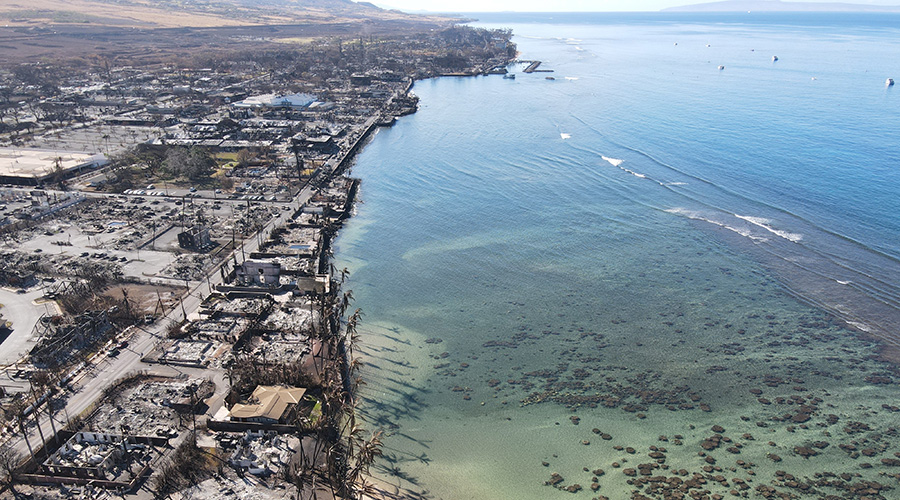Pandemic
Is bird flu a disaster waiting to happen...or just hype? Looking at the science can help facility executives weigh emergency planning options.
By Brandon Lorenz, Senior Editor
Tracking the Spread of Avian Influenza
H5N1 appeared in China a decade ago, then seemed to disappear. Since 2003, however, the virulent bird flu has spread among birds and people on three continents. Significant events in the disease’s spread in animals and humans are listed chronologically.
|
|
1996
|

China detects virus in farmed goose |

18 infections in Hong Kong, with 6 fatalities |
|
1997
|

Outbreaks in Hong Kong poultry farms |
|
| |
|
 |
|
|
While a horrified nation watched as Hurricane Katrina nearly destroyed New Orleans in late August 2005, the destruction shouldn’t have been a surprise to elected officials or residents of the area. Three years earlier, the local newspaper’s five-part series had precisely predicted what would happen if a hurricane made landfall in the Big Easy.
Avian influenza has generated headlines since the first case was reported in humans in 1996. A pandemic flu outbreak has the potential to cause millions of deaths worldwide, overburden health care systems and disrupt the world economy. But is a pandemic flu outbreak based on avian influenza like Hurricane Katrina — a disaster bound to occur eventually — or is the threat overblown? Although no one can answer that question, health care experts warn that the threat should be taken seriously.
“Complacency is really the enemy here,” says Lisa Koonin, chief of public and private partnerships for the Centers for Disease Control (CDC). “We can’t predict when a pandemic will occur, but we know they do occur and they occur in every century.”
Avian influenza — bird flu — is split into two categories. The low pathogenic form of the disease has relatively mild symptoms, according to the World Health Organization (WHO), while one highly pathogenic form of the bird flu virus — known as H5N1 — can spread rapidly through bird flocks, striking multiple organs and killing 90 percent of a flock within two days.
The current H5N1 outbreak is considered the most severe bird-flu outbreak on record, with an estimated 150 million birds killed by the flu or destroyed to keep the flu from spreading. And the virus has become more virulent since its emergence in 1996, developing the ability to kill poultry within 24 hours, says Yoshihiro Kawaoka, a virologist at the University of Wisconsin-Madison. The concern is the possibility that H5N1 will make the jump from birds to humans, and then spread from human to human, triggering a pandemic.
Influenza pandemics typically occur every 10 to 50 years, according to WHO. It is difficult to predict how severe a pandemic will be. A flu pandemic in 1918 was unusually strong, leading to about 40 million deaths worldwide, while pandemics in 1957 and 1968 were responsible for 2 million and 1 million deaths respectively.
With facility executives responsible for an ever-increasing list of tasks, from overseeing capital projects to keeping energy costs in check to managing space needs, the challenge is developing a measured response to the possibility of a pandemic.
The question is whether the next flu pandemic to develop will be based on H5N1. Such a pandemic has the potential to be especially destructive. “Low probability, high magnitude risks sometimes happen,” says Peter Sandman, a risk communications consultant based in Princeton, N.J. “The problem is that people often either reduce their sense of the probability to zero and say it’s too unlikely to worry about, or they inflate the possibility to the point where it’s easy to keep it on top of the list. They start saying that something is going to happen.”
WHO estimates that, at a minimum, a mild flu pandemic could kill between 2 million and 7.4 million people worldwide, but the health agency stresses that the estimate is only a rough one. More accurate predictions can only be made once the pandemic starts and its lethality is known. “If H5N1 turns into a pandemic, the severity of the disease could be as bad as 1918, or it could be worse,” says Kawaoka. “It is different than 1957 and 1968. That much is clear.”
Three conditions are required to ignite a pandemic: A new virus has to emerge; the virus has to be able to infect humans; and the virus has to be able to spread easily among humans. While the H5N1 virus currently meets the first two conditions, it does not yet meet the third. Since 2003, WHO has reported 232 cases of humans being infected with H5N1 and 134 fatalities, a 58 percent mortality rate. Most of those who died became infected after contact with infected birds.
Spreading Quickly
H5N1 is widespread in Asia, and though it has not yet been found in North America, it has spread to the Middle East and Europe. The first wave of the virus was documented in December 2003 with the death of four zoo animals in Thailand, followed by an outbreak the same month at a Korean poultry farm. Since then, H5N1 has been reported in wild birds or poultry in 51 countries, including Germany, England, France, Israel and Turkey, according to the World Organization for Animal Health. The virus could make its way to birds in North America this year, through migratory bird routes, Koonin says. Human cases have been reported in ten countries since 2003, including China, Iraq and Turkey.
Bird flu is spread among the bird population from farm to farm by the movement of birds, or the movement of people with contaminated clothing, equipment and feed. In humans, the disease is marked by fever, diarrhea, vomiting, and abdominal and chest pain. Many people who become infected also develop pneumonia, WHO says.
Kawaoka led a recent study that offered one possible reason why H5N1 does not yet spread readily among humans. According to the study, published in the journal Nature, flu viruses require a specific type of surface molecule called a “receptor” for the virus to enter a cell. The specific types of receptors required for H5N1 to be transmitted are present in humans, but only deep inside the lower respiratory system, the study says. For H5N1 to spread easily among humans, the virus would need to mutate in such a way that it could enter cells in the upper respiratory system.
The risk is that flu viruses are inherently unstable and constantly mutating, and H5N1 is no exception. “As flu viruses replicate, they create a lot of errors,” says Koonin. Those reproduction errors give the virus its ability to mutate.
One reason new flu vaccines must be engineered each year is to keep up with repeated changes in the virus — changes that make older vaccines ineffective. Given the long lead time required for vaccine production, there isn’t a way to prepare a vaccine for H5N1 in advance, because the current version of the virus will likely be different than the one that triggers a pandemic. That will have major implications for the way infected people are treated and how businesses will respond if a pandemic occurs.
A pandemic would be signaled when clusters of people closely related in time and place display flu symptoms, WHO says. Unlike the flu virus of 1918, which took about nine months to spread, a flu pandemic would spread quickly today. “Probably weeks after the pandemic is first located, it will be everywhere,” says Koonin.
Multiple waves are expected as the virus spreads, with the waves lasting up to three months. The waves could also vary in severity, with a relatively mild wave followed by one that brings more severe symptoms.
Not Like SARS
Facility executives shouldn’t allow themselves to be lulled into a false sense of security by the SARS outbreak that occurred in 2003, says Kawaoka. “With SARS we were extremely lucky,” he says. “SARS could have been a major pandemic.”
SARS — severe acute respiratory syndrome — is a viral illness that can lead to pneumonia. The disease is marked by fever and headache. The global SARS outbreak in 2003 infected 8,098 people, according to WHO. Of that total, 774 died.
One key difference between SARS and the flu is that SARS requires more prolonged exposure between humans to spread, while a flu pandemic would likely be easily spread by coughing or sneezing. H5N1 is also present in some poultry, domestic animals and wild birds, whereas SARS was not, complicating containment efforts.
While the timing and severity of a pandemic can’t be determined in advance, there is clear potential for economic disruption, particularly for businesses that have not prepared. The federal government’s “Implementation Plan for the National Strategy for Pandemic Influenza” includes assumptions that show what a pandemic might look like.
The plan predicts that the flu will strike 30 percent of the population overall, though illness rates could reach as high as 40 percent among children. An average of 20 percent of working adults are expected to become ill during an outbreak.
One challenge for facility executives is determining how to function during a pandemic outbreak when absenteeism is likely to surge. The implementation plan calls for companies to assume that 40 percent of staff members will be absent for two weeks at the height of a pandemic wave, with lower levels of absenteeism before and after the wave peaks.
The ability of private companies to sustain operations factors into the nation’s ability to handle a pandemic flu outbreak — most of the critical infrastructure needed to safeguard national security, economic security or public health and safety lies with the private sector, according to the implementation plan.
The first four to six months during a pandemic will be key for many businesses because it will likely take at least that long to develop a vaccine for a pandemic virus, Koonin says.
A report from the International Monetary Fund gives added reason for facility executives to plan for an outbreak. While the outbreak of 1918 was unusually severe, the economic fallout was limited because the nation was in the midst of World War I. Missing work at that time hurt workers harder financially, and there was likely pressure not to miss work given the war, the IMF says. Today, on the other hand, economic disruptions could be more severe given the global economy, particularly if companies aren’t prepared for a pandemic outbreak in advance. A pandemic flu outbreak in India, for example, could have ripple effects for companies with offshore call centers and no contingency plans.
Some companies are considering requiring their key vendors to undertake pandemic flu planning as part of contractual agreements, Koonin says.
“Think about your supply chain,” she says. “Nobody carries inventory today. How could you create and execute a plan in two weeks to preserve the continuity of your business if you haven’t done any planning ahead of time? It’s not going to be easy.”
How prepared facility executives are to handle a pandemic flu outbreak remains to be seen. A member survey conducted by the International Facility Management Association in April indicated that a majority — 51 percent — did not consider a pandemic flu outbreak to be a serious or probable business threat. Of those surveyed, 48 percent said a response plan was complete or underway, while 52 percent said a response plan had either not been considered or that no additional planning beyond a business continuity plan had taken place.
One important message for facility executives: Don’t wait for help if a pandemic occurs. Unlike localized events such as hurricanes, earthquakes or power outages, a pandemic will be a widespread and sustained event, lasting between six to 12 weeks in a community. Federal assistance will likely be limited because of the sheer demand for services.
“A pandemic will occur all over the world, and in this country it will occur in multiple communities at the same time,” says Koonin. “There will be so many places simultaneously affected that you can’t look to others for help.”
How Avian Influenza Could Become Pandemic Influenza
Avian influenza is the common name for a large group of different influenza viruses that primarily affect birds. Occasionally, bird flu can infect humans. A pandemic flu attack occurs when a type of flu virus that has not previously infected humans emerges. The virus spreads rapidly because humans have no built-in immunity to it.
While H5N1 has infected a small number of humans, it does not yet have the ability to jump easily from human to human. Most of the people infected by H5N1 contracted the disease after being exposed to infected birds. But if H5N1 mutated into a form that could be transmitted easily among humans, it could develop into a pandemic.

WHO maintains a global alert system that monitors the likelihood of a pandemic flu outbreak. The current alert level is phase 3, which means a new flu is causing disease in humans but is not yet spreading easily among humans. According to WHO, the world is now closer to another influenza pandemic than at any time since the last pandemic in 1968.
— Brandon Lorenz
|
Starting Point for Plans:
Key Items for Facility Operations
While planning for a flu pandemic should begin at the corporate level, a successful approach must involve representatives not only from management, but from human resources, communications, IT, legal and compliance, and facilities. And it should begin with a careful look at what a flu pandemic infecting up to 40 percent of an organization’s key employees would really mean.
From a facility perspective, that means compiling a list of critical questions, say industry experts and sources like a report from the Building Owners and Managers Association (BOMA) International, “Addressing the Threat to Commercial Buildings of an Avian Flu Epidemic.” Crucial questions include:
- Which building systems are mission-critical, and what is the bare minimum staff required to support their operation?
- Which staff are currently trained to operate critical systems and what specific skills make them qualified?
- Which non-facility staff perform functions essential for facility operations (i.e., purchasing)?
- Which if any critical building operations can be managed remotely? Can other systems be upgraded to allow remote operations, and if so, what would these upgrades cost?
- What would happen if any given facility had to be closed because of quarantine or staff shortages?
- What vendors or contractors perform essential functions?
- What supplies are needed for the support of critical facility functions?
- Which employees perform tasks that cannot be performed off-site, and where are these employees located?
The answers to these questions will go a long way toward forming the basis of a pandemic plan. In all likelihood, they will point to a number of key action steps that include:
- Cross-training employees within the facility department to cover one another’s responsibilities.
- Collaborating with other departments or sites to provide cross-training for facilities support functions.
- Developing contingency plans for the acquisition of crucial supplies should delivery schedules be disrupted, or for the advance purchase of bulk supplies.
- The development of “how to” notes describing step-by-step execution of critical tasks.
- The establishment of infrastructure to support the IT systems that will facilitate large numbers of employees working from home.
Pandemic planning should address interventions from the minor — whether and when to close down coffee stations and water coolers — to the extreme — how to equip a facility with days or weeks worth of food and supplies in case key employees need to quarantine themselves, and possibly their families, inside. Communications plans should be spelled out well in advance, and e-mail lists established for all staff, vendors and contractors. And pandemic action plans should be practiced.
“Some companies are having pandemic exercises where they are going to arbitrarily have 20 percent of their workforce work remotely from home for a week or two and see what issues come up,” says Susan Nuccio, vice president and director of business continuity, Jones Lang LaSalle. “Another way to approach it would be to run through it theoretically: What if only two of our six engineers can show up? What would that look like?”
The sheer volume of planning can leave facility executives feeling overwhelmed. But, says Karen Avery, a business continuity management practice leader for Marsh Risk Consulting, pandemic planning should be regarded as part of an overall business continuity plan.
“Don’t take the threat approach,” she says. “There are so many specific threats out there that there is no way you can comprehensively plan for each one separately. It is much more cost-effective to just look at the impact of the loss of any of a number of key resources — whether it is staff, key contractors, facilities, technology, or departments — and plan for it. That way you will be covered, no matter which specific threat arises.”
— Abigail Gray, contributing editor
|
To Prepare for a Pandemic, Put Business Relationships Under a Microscope
A thorough process of reviewing and clarifying any and all contractual relationships is an important part of pandemic planning.
“What a pandemic will affect primarily is people and relationships, so you really need to understand who you depend on and who depends on you,” says Karen Avery of Marsh Risk Consulting.
As a first step, experts suggest ranking the organization’s vendors and contractors in priority order. Which contracted services are mission-critical, and which could the organization do without for a few months if need be?
“You need to determine which vendors are critical, and then perform due diligence to ensure that they have well-conceived pandemic response plans in place to ensure that they are able to provide contracted services when a pandemic occurs,” says Jim Rosenbluth, managing director for crisis management with Cushman & Wakefield.
Clarifying roles and obligations verbally is important, but a careful review of legal documents is also essential.
“There is question about whether a pandemic might activate force majeure clauses in some contracts,” explains Avery. “The time to modify your contracts to clarify exactly what level of service you will receive in the event of a pandemic is now. When the pandemic is underway, it will be too late.”
For the most crucial contracts, consider whether it makes sense to negotiate priority service in the event of a flu pandemic.
“I am aware of at least two instances of organizations that have agreed to pay a premium now so that, should they be hit by the pandemic, they will have first dibs on their contractors’ services,” says Avery. “There will be many things that are beyond your control, but there are some steps you can take in advance to make sure your business will be taken care of.”
Similarly, it is important to consider in advance the impact of a pandemic on the facility staff. Don’t assume that the HR department will handle this issue; while HR will likely develop staff policies and procedures for the organization as a whole, facility executives need to understand the impacts of issues like union rules on their own workers. In addition, well-thought-out policies related to overtime pay or other incentives may become important tools for keeping key staff members engaged during the height of a pandemic, when employees may be hesitant to come to work.
It is also important to scrutinize the organization’s obligations to clients or tenants if a pandemic strikes.
“You have to think about all the potential scenarios,” says Susan Nuccio of Jones Lang LaSalle. “If a government official shuts down a building because of a pandemic, you have no choice but to comply. But then how are you going to manage that building and provide the services you are contracted to provide?”
“I am seeing a trend toward tenant-model planning that factors in issues like communication with tenants, the provision of temporary space, and emergency cleanup services,” says Avery. “Our clients are being asked by their tenants what their plan is.”
— Abigail Gray
|
Little Things Count:
Cleaning Will be Critical for Business Continuity
One of the most essential functions of any facility department in the event of a pandemic will be the implementation of a rigorous cleaning regimen to inhibit the spread of the contagion within the property. Regular and strategic disinfecting with appropriate cleaning products will be essential for protecting employees’ health and ensuring business continuity.
“Establishing janitorial protocols is one of the most important tasks at the property level,” says Jim Rosenbluth of Cushman & Wakefield.
What exactly should those protocols entail? Given the volume of information — and misinformation — currently circulating about avian flu, determining the best combination of janitorial procedures and products presents a challenge. Several organizations are working on guidelines to help facility executives develop protocols for maintaining a healthy environment, including janitorial best practices. For instance, the Center for Infectious Disease Research and Policy (CIDRAP) at the University of Minnesota is at work on guidelines for businesses that should be available by fall; facility executives interested in receiving CIDRAP’s Business Briefing on flu and other infectious disease-related threats can sign up now on the organization’s Web site. In the meantime, health experts advise an approach that is grounded in common sense.
“Just think in terms of the cleaning procedures you should be using now to protect your employees from the regular annual flu or other colds and viruses,” advises Judy Althoff, a registered nurse who provides employee health services to corporations. “A good cleaning program that protects against these routine threats is also going to be effective if there is a pandemic.”
In addition, says Rosenbluth, “cleaning and sanitation protocols should be developed based on the characteristics of the building, its usage and traffic patterns.”
In an office building, for instance, protocols might call for the scrubbing of elevator buttons as often as hourly. In a retail facility, priorities might be the regular disinfection of ATM machines, door pulls and checkout counters. Experts recommend that cleaning protocols be benchmarked against established guidelines — like the World Health Organization’s pandemic threat level system — so that sanitation procedures are automatically stepped up as the identified threat increases.
Working in collaboration with human resources and workplace medical personnel, facility departments can further minimize the threat of workplace avian flu infection by keeping employees and vendors informed and providing them with the tools to protect themselves. Steps might include placing hand-sanitizer dispensers throughout the facility; providing each employee with a bottle of disinfecting spray to keep phones, keyboards and work surfaces clean; and posting signage about proper hand-washing techniques.
As with all aspects of business continuity planning, say experts, the important thing is thinking ahead.
“We have identified a list of pandemic-related disinfecting and personal hygiene products that we will issue to our employees, and distribute at our properties if and when a pandemic occurs,” says Rosenbluth. “Likewise, we have developed corporate guidelines to help each of our property managers develop pandemic preparedness plans tailored to the properties they are managing.”
— Abigail Gray
|
In a Health Crisis, Security Steps into Unknown Territory
Second in importance only to cleaning in the event of an avian flu pandemic, security also demands careful and strategic planning.
“Major concerns related to security in a flu pandemic are going to be around perimeter protection and internal protection,” says Karen Avery of Marsh Risk Consulting.
First and foremost, facility executives should think about how they will supplement existing security measures should the need arise to keep sick people out. Many organizations will likely designate certain clean facilities to protect critical employees whose jobs cannot be done from home. This approach, which hinges upon security procedures that effectively prevent infected individuals from entering that building, opens a Pandora’s box of new challenges.
“There are thermal scanners that can detect if someone has a fever, and systems that can screen people’s DNA with a swab taken from inside their cheek,” says Susan Nuccio of Jones Lang LaSalle. “But even if you do go with a high-tech system there will be issues. If a thermal scan shows that someone has an elevated temperature, is it because they are sick or because it’s a hot day? And what do you do if someone shows signs of illness? Send them home? Send them to a hospital? The security policies will need to be very clear to provide guidance on handling situations like these.”
Other security issues will vary with the type of facility. For organizations that depend on frequent deliveries, for instance, new procedures may be required to prevent drivers and delivery personnel from actually entering the facility. Retail establishments may face particular challenges: How can even someone who is obviously sick be prevented from entering a retail store? And how can a security approach be devised that safeguards occupants’ health without cutting off a retail establishment’s lifeblood?
As with all aspects of flu pandemic planning, the development of a sound security strategy demands a collaborative approach. Facility executives must work closely with their organizations’ HR and legal personnel to ensure that any planned security tactics balance the goal of maintaining a flu-free environment with employees’ privacy rights and corporate sick and time-off policies. And, as with all aspects of a pandemic plan, the security planning must extend beyond the “what” and “how” questions to examine the critical issue of “who.”
“Is your security currently provided by a contractor? Who are they and are they going to be able to handle this? How many clients do they have and does your organization have priority status? Can they really meet the needs of a pandemic?” asks Avery. “If you can’t answer these questions with certainty, you may need to make some changes, and the time to think about that is now.”
— Abigail Gray
|
Related Topics:















